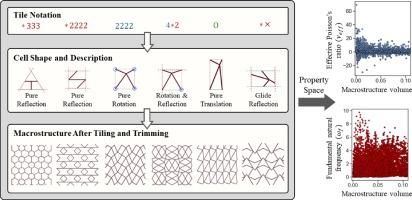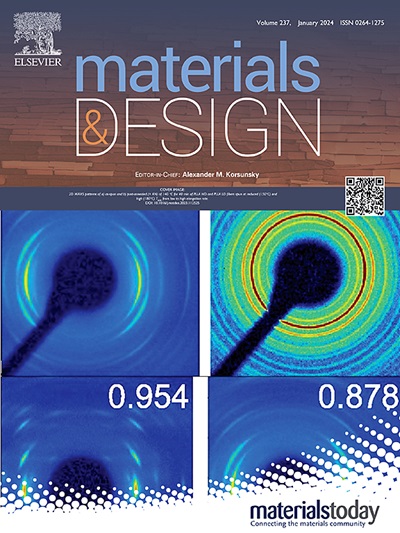Tiling-based lattice generation for structural property exploration
IF 7.6
2区 材料科学
Q1 MATERIALS SCIENCE, MULTIDISCIPLINARY
引用次数: 0
Abstract
Advancements in additive manufacturing enable the development of artificial lattice structures with unique properties not found in natural materials. Specifically, filament-based lattices are known for having a lightweight yet strong nature, exhibiting auxetic behavior and excellent energy absorption capabilities. Recent research has focused on developing algorithms and frameworks to manipulate cell geometry and material properties to achieve unusual properties. However, the exploration of the full design space is hampered in practice primarily due to restrictions on cell tiling variation. Here, for the first time, a Tiling-Based Lattice Generation (TBLatGen) framework is presented that relies on various tiling operations and stochastic changes in internal cell geometry. By utilizing reflections, rotations, glide reflections, translations, and combinations of these operations, lattice structures are tiled to achieve an extensive range of properties. For instance, achieving Poisson's ratios ranging over at least ±20 using a minimal set of design parameters is demonstrated, a range unprecedented in prior studies. Experimental testing of a physical prototype validates the auxetic behavior of one newly proposed tiled lattice structure. Beyond this, the proposed TBLatGen framework is anticipated to be applicable to general periodic metamaterials, enabling the design and discovery of new structures exhibiting exceptional mechanical, thermal, electrical, or magnetic properties.

基于平铺的网格生成技术探索结构特性
增材制造技术的进步使得人工晶格结构的开发成为可能,这种结构具有天然材料所不具备的独特性能。具体来说,丝状晶格以其轻质而坚固的特性著称,表现出辅助行为和出色的能量吸收能力。最近的研究主要集中在开发算法和框架,以操纵晶胞几何形状和材料特性,从而实现不同寻常的特性。然而,在实践中,对整个设计空间的探索受到了阻碍,这主要是由于对单元平铺变化的限制。本文首次提出了基于平铺的晶格生成(TBLatGen)框架,该框架依赖于各种平铺操作和内部单元几何的随机变化。通过利用反射、旋转、滑动反射、平移以及这些操作的组合,平铺晶格结构可实现多种特性。例如,利用一组最小的设计参数就能实现至少 ±20 的泊松比,这是以往研究中从未有过的。对物理原型的实验测试验证了一种新提出的平铺晶格结构的辅助行为。除此之外,所提出的 TBLatGen 框架预计将适用于一般周期性超材料,从而能够设计和发现具有特殊机械、热、电或磁特性的新结构。
本文章由计算机程序翻译,如有差异,请以英文原文为准。
求助全文
约1分钟内获得全文
求助全文
来源期刊

Materials & Design
Engineering-Mechanical Engineering
CiteScore
14.30
自引率
7.10%
发文量
1028
审稿时长
85 days
期刊介绍:
Materials and Design is a multi-disciplinary journal that publishes original research reports, review articles, and express communications. The journal focuses on studying the structure and properties of inorganic and organic materials, advancements in synthesis, processing, characterization, and testing, the design of materials and engineering systems, and their applications in technology. It aims to bring together various aspects of materials science, engineering, physics, and chemistry.
The journal explores themes ranging from materials to design and aims to reveal the connections between natural and artificial materials, as well as experiment and modeling. Manuscripts submitted to Materials and Design should contain elements of discovery and surprise, as they often contribute new insights into the architecture and function of matter.
 求助内容:
求助内容: 应助结果提醒方式:
应助结果提醒方式:


